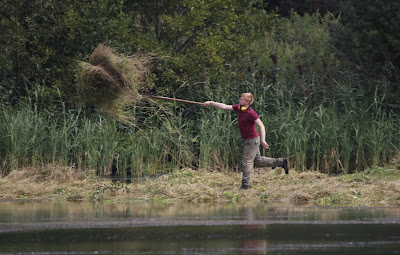With Autumn upon us anything is possible so I thought it was worth taking a trip to the west and inland Suffolk and particularly Lackford Lakes, the best reserve in the area. Now Lackford is worth visiting, it has good numbers of commoner birds, providing great opportunities for photography, and I get the feeling I'm going to get lucky and eventually see something good there. Well luck wasn't on my side, I didn't see anything special, so I'll have to leave it to another time, such are the joys of birdwatching.
We arrived around half ten, had a coffee in the centre and took some photos of the birds on the feeders. Amongst the more common birds, such as BLUE and GREAT TITS, was a MARSH TIT. Nothing much had been seen around the reserve, except a SPOTTED CRAKE, but apparently you had to get up at five in the morning to see it - so no chance.
We left the centre and headed around the sailing lake. This is the largest of Lackford's lakes, but as the name suggests is used for sailing, which it was today. However there were large numbers of birds feeding on the water weeds around the edges. Around seventy MUTE SWANS were present as well as several hundred each of GADWALL and COOT with smaller numbers of TUFTED DUCK.
The first hide we went to, Paul's Hide, overlooked the Slough. It was busy with people, and we had to wait to get seated. However this was the only place like that and the rest of the hides were quiet. Everyone was there to photograph KINGFISHERS, of which this reserve is famous for. One bird was present, perched on different tree branches between fishing, but was too distant to get a decent image. It was joined by a second which it saw off. Also sharing the same area was a SEDGE WARBLER.
View over the Slough - notice all the waterweed great food for DUCKS
It was a long walk to the eastern lakes, five lakes of differing size and habitats. The path passed through Ash Carr an overgrown area of wet woodland. In this area is the famous Stump, an overturned tree trunk where over the years bird photographers had been putting out seeds to attract birds down to feed and have photos taken of. Ok, we did put some seed out, and took some photos, but we found out later that the act of doing it is looked down upon, and shouldn't be done. It is a nature reserve after all, not a zoo. Small birds seen in the woods included NUTHACH, two TREECREEPERS, MARSH TIT and a GOLDCREST, all associating themselves with the commoner birds in large flocks.
A MARSH TIT - its plumage is more subdued than other TIT species. Despite its name it is seldom found in marshes, favouring old woodland.
The announcement we were coming to Long Reach lake was made by the sound of buzzing in the air. Strimmers were being used by a work party to cut the grass on the islands, for the benefit of winter ducks. That meant that all birds were sheltering in the extreme corner of the lake.
A work party, strimming and raking - around 90% of habitat management
Several LITTLE GREBES were present including an old family party, as well as GREAT CRESTED GREBES. There was also a small flock of EGYPTIAN GEESE, which is unusual as you usually just see them in pairs.
EGYPTIAN GOOSE
Well that was Lackford, plenty of birds as you have seen, just not anything exciting. You expect the bigger reserves to pay out, to provide the big bird experiences which helps you keep going on the local parches, where birds are less obvious. But I still enjoy going, I like inland lakes, it is the kind of habitat I first started birding in when I was young, at places like Tring Reservoirs and College Lake.
Micklemere
With time left we decided to have a look at Micklemere, another Suffolk Wildlife Trust reserve. We parked up, and enetered the hide that overlooks the reserve and were in for a shock. Last time we visited in March the reserve was a lake with areas of wet grassland. Today there was no water - the mere had all dried up. It was just an area of rough grassland grazed by sheep. There were no birds except a flock of GEESE.
The view over Micklemere
Livermere Lake.
I had bought a new map of the area. With Micklemere not producing we had a look and saw a small lake around ten miles away, cut in half by a footpath - it was worth a look. The lake was a remnant of a country estate that was now defunct. The lake was artificial with no vegetation around the sides, just mud. The lake seemed to be used for duck hunting, with shooting butts along the edges. That resulted in large numbers of introduced MALLARDS being present, introduced to be shot. I didn't bring my scope so I couldn't really see too much, but it seemed fairly quiet.
West Suffolk is not really known for good birdwatching away from the big reserves. I did try to diversify with different areas to Lackford, but they proved to be fairly unproductive. They didn't seem worth the trip really, more like local patch reserves. I'll still keep visiting the area though, because it has promised me something good, and I'll hold it to its word










No comments:
Post a Comment